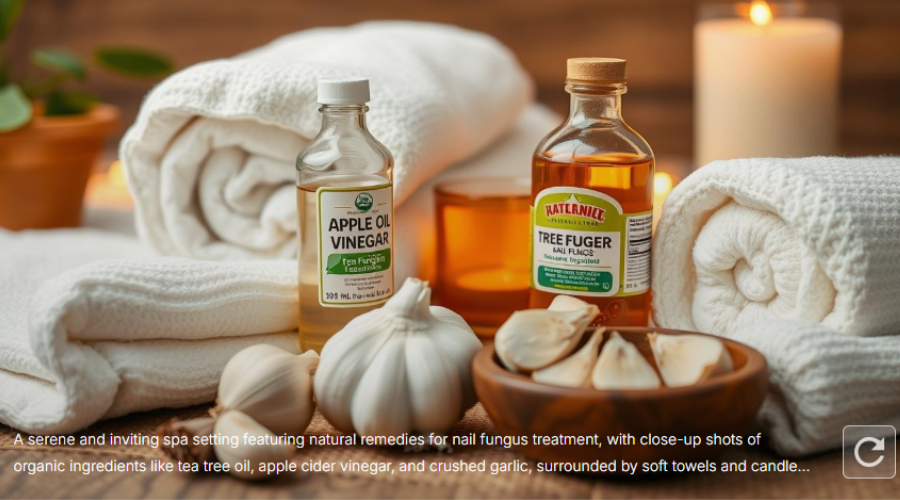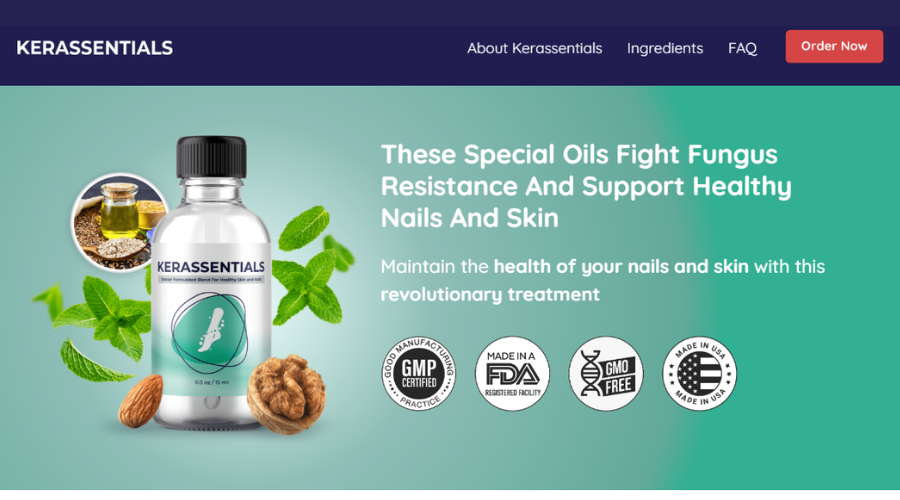Cure Nail Fungus Naturally
Nail fungus, also known as toenail fungus or fungal nail infection, is common. It’s good to know that you can treat it naturally. Kerassentials is a product that fights fungus and helps keep your nails and skin healthy.
Dealing with fungal nail infections can be tough. But, with the right steps, you can cure it and stop it from coming back. Poor hygiene, genetics, and some health issues can cause it. Toenail fungus is especially hard to treat, but natural remedies can help.

A serene and inviting spa setting featuring natural remedies for nail fungus treatment, with close-up shots of organic ingredients like tea tree oil, apple cider vinegar, and crushed garlic, surrounded by soft towels and candles, highlighting a calming atmosphere with earthy tones and textures.
Knowing what causes and shows nail fungus is key to treating it. A natural way to fight nail fungus includes changing your diet, your lifestyle, and using topical treatments. Treating fungal nails takes time and effort. But, with the right approach, you can get rid of fungus and have healthy nails.
Key Takeaways
- Nail fungus can be treated naturally with products like Kerassentials
- Understanding the causes and symptoms of nail fungus is essential for effective treatment
- Natural remedies, such as dietary changes and lifestyle modifications, can be effective in combating nail fungus
- Toenail fungus can be challenging to treat, but natural approaches can be successful
- A fungal nail treatment requires patience and dedication to achieve healthy, fungus-free nails
Understanding Nail Fungus and Its Causes
Nail fungus, also known as onychomycosis, affects millions globally. It’s a fungal infection caused by poor foot hygiene, sharing items, and tight shoes. To stop it, keep your feet clean and dry. Also, use nail fungus medication when needed.
There are several types of fungal nail infections. Each has its own symptoms and treatment. Knowing the causes and types helps in finding the right treatment and stopping the infection.
Common Types of Fungal Nail Infections
- Distal subungual onychomycosis: This is the most common type, affecting the tips of the nails.
- White superficial onychomycosis: This type causes white patches on the nail surface.
- Proximal subungual onychomycosis: It affects the base of the nail, making it thick and discolored.
Risk Factors for Developing Nail Fungus
Risk factors include poor foot hygiene, sharing items, and tight shoes. To lower your risk, keep your feet clean and dry. Also, use nail fungus medication if needed.
Identifying Your Nail Fungus Condition
To treat nail fungus, knowing the type of fungal infection is key. A doctor or dermatologist can help with this. They might do a physical check, nail scraping, or fungal culture to find out what’s causing the nail infection.
There are many types of fungal infections. For instance, onychomycosis makes nails thick, discolored, and brittle. Knowing the type of nail infection you have is important for choosing the right treatment.
- Location: Where is the infection located? Is it on the toenails or fingernails?
- Appearance: What does the infection look like? Is it yellow, brown, or black?
- Symptoms: Are there any symptoms, such as pain, itching, or redness?
Understanding your nail fungus and its signs helps you and your doctor find the best treatment for treating nail fungus.
Essential Natural Remedies for Nail Fungus Treatment
Natural remedies are a favorite for treating nail fungus. They are effective and have fewer side effects. Tea tree oil is a top choice because it fights fungal infections well.
Some popular natural remedies for nail fungus treatment include:
- Tea tree oil solutions, which can be applied topically to the affected area
- Apple cider vinegar treatment, which can help balance the pH of the skin and prevent fungal growth
- Oregano oil applications, which have antifungal properties that can help treat fungal infections
- Garlic-based treatments, which have antifungal and antibacterial properties that can help combat nail fungus
These natural remedies can be used as a cure for nail fungus or with other treatments. Kerassentials, a natural treatment with tea tree oil, is effective against nail fungus. It’s important to talk to a healthcare professional before trying any new treatment.
Good foot hygiene is also key to preventing fungal infections. Wear clean socks, trim toenails straight, and don’t share personal care items. Combining natural remedies with good foot care can help prevent and treat fungal nail treatment effectively.
Dietary Changes That Combat Fungal Infections
To fight fungal nail infections, changing your diet is key. Eating foods rich in antioxidants, vitamins, and minerals boosts your immune system. This makes it easier to fight off fungal infections. Avoid foods high in sugar and processed ingredients, as they weaken your immune system.
Drinking plenty of water is also important. It helps remove toxins and keeps your body working right. Adding probiotics to your diet is also good. Foods like yogurt, kefir, and fermented veggies are full of probiotics.

A close-up arrangement of fresh, vibrant foods known for their antifungal properties, such as garlic, ginger, and turmeric, surrounded by green leafy vegetables. Include a subtle backdrop of soft, natural textures like wood or stone that evoke a sense of health and wellness. The scene should be well-lit, showcasing the freshness and colors of the ingredients, with an emphasis on a nourishing vibe.
- Leafy green vegetables
- Berries
- Nuts and seeds
- Whole grains
- Lean proteins
These foods give you the nutrients and antioxidants you need. They help keep your immune system strong and prevent fungal infections.
By making these dietary changes, individuals can take a proactive approach to treating nail fungus and preventing future infections.
Natural Foot Soaks and Topical Applications
Natural foot soaks and topical applications are great for treating nail fungus. They can lessen symptoms and help nails grow healthy. An Epsom salt soak is popular because it reduces inflammation and softens the nail.
Baking soda solutions are also effective. They balance the skin’s pH, stopping fungus from growing. Essential oils like tea tree and lavender are good too. They have antifungal properties that fight nail fungus and prevent more infections.
Using natural foot soaks and topical applications has many benefits. They are:
- Less likely to cause side effects than traditional medicines
- Cost-effective and easy to find
- Can be used with other treatments for better results
But, these remedies might not work for everyone. If your nail fungus doesn’t get better, see a doctor. They can help you find the right treatment. With natural remedies and medical help, you can get rid of nail fungus and have healthy nails.
| Remedy | Benefits | Risks |
|---|---|---|
| Epsom salt soak | Reduces inflammation, softens nail | May cause dryness or irritation |
| Baking soda solution | Neutralizes pH, prevents fungus growth | May cause skin irritation in some individuals |
| Essential oil blends | Antifungal properties, promotes healthy nails and skin | May cause allergic reactions or skin irritation |
Lifestyle Modifications to Support Healing
When treating nail fungus, changing your lifestyle is key. It helps prevent the infection from coming back. Simple daily changes can stop fungal nail treatment from being a constant problem.
Keeping your feet clean is vital to stop fungal infections. Wash your feet every day and dry them well, especially between the toes. Regular foot care is a big help in preventing nail fungus. Also, wear shoes that breathe and fit well to keep your feet dry and cool.
Footwear Recommendations
- Wear shoes made of breathable materials, such as leather or mesh
- Avoid sharing shoes or wearing shoes that are too tight
- Keep your shoes clean and dry, especially after exercising or engaging in activities that make your feet sweat
Exercise and good blood flow are also important for healthy feet. Regular exercise boosts blood flow to your feet, helping prevent fungal infections. Treating nail fungus needs a mix of lifestyle changes and treatment options.

A close-up of healthy, well-groomed feet on a wooden floor, surrounded by natural ingredients like tea tree oil, vinegar, and garlic cloves, with a small potted plant in the background, emphasizing a clean and serene environment.
Adding these lifestyle changes to your daily life helps heal and prevent future fungal infections. Remember, preventing nail fungus is a long-term effort. It requires paying attention to foot hygiene and overall health.
| Lifestyle Modification | Benefits |
|---|---|
| Proper foot hygiene | Prevents the spread of fungal infections |
| Wearing breathable shoes | Keeps feet dry and cool, reducing the risk of fungal growth |
| Regular exercise | Improves blood flow to the feet, helping to prevent fungal infections |
When to Seek Professional Medical Help
If you have a fungal nail infection that won’t go away, you need to see a doctor. They can figure out what’s wrong and suggest the best nail fungus treatment. This might include nail fungus medication that you can only get with a prescription.
Look out for signs like more pain, redness, and swelling around your nail. If you see these, it’s time to visit a doctor. They can tell you the best way to treat it and stop it from getting worse.
Some fungal nail infections can’t be fixed with over-the-counter stuff. In these cases, a doctor might give you medicine to take or apply to your nails. Getting help from a doctor means you’ll get the best treatment and keep your nails healthy.
When you decide to see a doctor, think about a few things. Consider how bad your symptoms are, if other treatments worked, and your health history. This way, you and your doctor can create a plan that’s just right for you. It will help you get rid of the fungus and keep your nails looking good.
Conclusion: Your Path to Healthy, Fungus-Free Nails
In this guide, we’ve looked at nail fungus, its causes, and natural ways to fight it. To get healthy, fungus-free nails, a holistic approach is essential.
Using natural treatments like tea tree oil and apple cider vinegar can help your nails. Also, making dietary changes and lifestyle tweaks boosts your immune system. This makes it harder for fungus to grow.
Good foot hygiene, the right shoes, and exercise help fight off fungus. If it’s tough to get rid of, see a doctor for help.
Your nails show your health. With the right steps, you can have beautiful, healthy nails. Try these natural methods and start your journey to fungus-free nails.
FAQ
What is nail fungus and how common is it?
Nail fungus, also known as onychomycosis, is a common infection. It affects the toenails or fingernails, making them thick, discolored, and brittle. It’s estimated to affect up to 14% of people, becoming more common with age.
What are the main types of fungal nail infections?
There are three main types of fungal nail infections. These include distal subungual onychomycosis, white superficial onychomycosis, and proximal subungual onychomycosis. Each type has its own characteristics and causes.
What are the risk factors for developing nail fungus?
Several factors increase the risk of getting nail fungus. These include poor foot hygiene, sharing personal care items, and wearing tight footwear. A weakened immune system and a history of fungal infections also play a role.
What are the signs and symptoms of nail fungus?
Signs of nail fungus include thickening and discoloration of the nail. The nail may also become brittle or crumble. In some cases, a foul odor can occur.
How can I identify the type of nail fungus I have?
To identify the type of nail fungus, see a doctor or dermatologist. They can perform a physical exam, nail scraping, or fungal culture. This helps determine the specific type of fungal infection.
What are some natural remedies for treating nail fungus?
Natural remedies for nail fungus include tea tree oil, apple cider vinegar, and oregano oil. Garlic-based treatments also help fight the fungus and promote healthy nail growth.
How can dietary changes help combat fungal infections?
Eating a healthy diet rich in antioxidants and vitamins helps fight fungal infections. Avoid sugary and processed foods. Staying hydrated is also important.
What natural foot soaks and topical applications can help treat nail fungus?
Natural treatments include Epsom salt soaks, baking soda solutions, and essential oil blends. These, especially those with tea tree oil and lavender oil, can fight the fungus and promote healthy growth.
What lifestyle modifications can help prevent and treat nail fungus?
To prevent and treat nail fungus, maintain good foot hygiene. Wear well-fitting, breathable footwear. Regular exercise improves circulation, which helps.
When should I seek professional medical help for nail fungus?
If your nail fungus causes pain, redness, swelling, or doesn’t improve with natural treatments, seek medical help. Your doctor may prescribe medications to treat the infection.




Can you be more specific about the content of your article? After reading it, I still have some doubts. Hope you can help me.